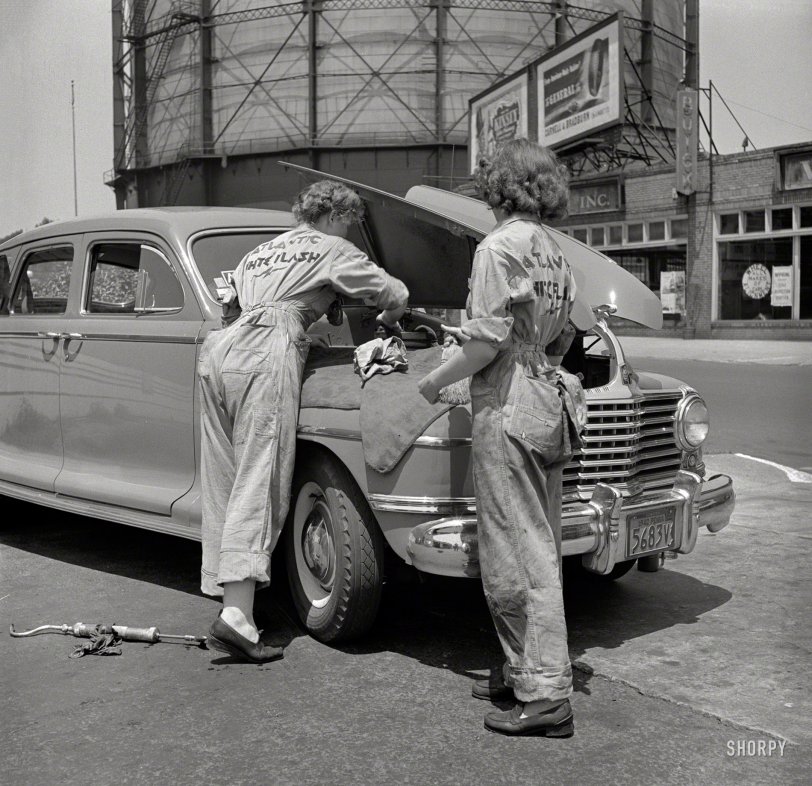


Framed or unframed, desk size to sofa size, printed by us in Arizona and Alabama since 2007. Explore now.
Shorpy is funded by you. Patreon contributors get an ad-free experience.
Learn more.

- Details, Details
- What's that building to the left of the tower?
- Coal Barges
- Bromo-Seltzer
- Inner harbor
- The Basin
- What a headache!
- Giant stepladder?
- Baldwin 62303
- Baldwin VO-1000
- Cold
- No expense spared
- Tough Guys
- Lost in Toyland
- And without gloves
- If I were a blindfolded time traveler
- Smoke Consumer Also Cooks
- Oh that stove!
- Possibly still there?
- What?!?
- $100 Reward
- Freeze Frame
- Texas Flyer wanted
- Just a Year Too Soon
- WWII -- Replacing men with women at the railroad crossing.
- Yes, Icing
- You kids drive me nuts!
- NOT An Easy Job
- I wonder
- Just add window boxes
Print Emporium
White Flash: 1943

June 1943. "Philadelphia, Pennsylvania. Women garage attendants at the Atlantic Refining Company." The hard part here was figuring out that crazy clamshell hood. Photo by Jack Delano for the Office of War Information. View full size.
That Corner
HistoricAerials.com still shows those billboards on top of the Buick dealer on the northeast corner of 47th & Chestnut streets in 1950. The gasholder is on the northwest corner.
Bumper Jack
If you enlarge the photo and look just left of the left knee of the lady on the right, you can see the reflection of the photographer, Jack Delano, in the shiny car bumper as he is taking the photo.
Lost inspiration
If the writers of the "I Love Lucy" show back in the early fifties had seen this photo, there would probably have been a classic episode of Ethel Mertz and Lucy working at an auto service center. Oh well, you can always write your own.
Last Call for Cars
This would be one of only 22,055 Dodge Custom four-door sedans built in that war-shortened year (more may have been made for government use), but I'm sure it had Fluid Drive to absorb some of its 101 horsepower from a slightly enlarged flathead six.
There was an even rarer (13,000 built) example of the less expensive DeLuxe sedans with the blacked out trim here in town as late as the 70's and I've always wished I'd bought it!
Rethinking West Philly "Gas"
The gas stored in containers like these would be of the manufactured variety-- a by-product of a coal carbonization process that yielded a gas that was both toxic and heavier than air at atmospheric densities. In those days, manufactured gas consumers could and did asphyxiate themselves by simply turning on an unlit stove burner in their home. It was the toxic constituents in the gas that did them in. Save for legacy manufacturing sites subject to environmental remediation, manufactured gas has been almost totally supplanted by natural gas as piped to customers through distribution utilities. "Natural gas" as we consumers know it today comes out of the ground, is delivered through interstate pipelines, and is odorless until the mercaptan odorant is added for safety.
Pants
Love the cargo pants part of the coveralls ... although the cuffs need work.
Dress Shoes?
Looks like the ladies are wearing loafers (without socks, too). I guess workplace regulations at that time did not require steel toe work boots. My mechanic says he would never work without them; he's lost track of how many times he's dropped something on his foot....
Full Service
I remember full service back in the day when the attendant would check your oil, clean your windshield and maybe even check your tire pressure. But the young lady with the whisk broom? What's she going to do, sweep out the interior? That's really full service.
Gasoline and Gas
Another great view of a gasometer right behind them. Would not want to be there if that thing blew up!
West Philly Gas
I would suggest the image is taken from the southwest corner of Chestnut Street at Markoe Street (now called Farragut St)in West Philadelphia, looking towards the large natural gas storage tank at 47th and Chestnut. The gas tank is gone, but a BP station remains where these ladies were checkin' under the hood.
It looks like a
LaSalle.
[Not even close. - Dave]
























On Shorpy:
Today’s Top 5